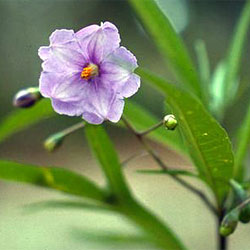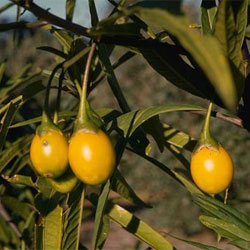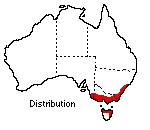Solanum laciniatum
 |
 |
Kangaroo Apple
Solanum is the type genus of the family Solanaceae, which contains such well-known economic plants as the potato, tomato, tobacco, egg plant (aubergine) and many more. In Australia there are 117 species, of which 87 are endemic.
 Solanum
laciniatum or Kangaroo Apple, a common name shared with the closely related S. aviculare, occurs in temperate regions of New South Wales, the Australian
Capital Territory, Victoria, South Australia, Tasmania, New Zealand and associated
islands on a range of soil types. It forms a large shrub 4 m high by 5 m wide.
Solanum
laciniatum or Kangaroo Apple, a common name shared with the closely related S. aviculare, occurs in temperate regions of New South Wales, the Australian
Capital Territory, Victoria, South Australia, Tasmania, New Zealand and associated
islands on a range of soil types. It forms a large shrub 4 m high by 5 m wide.
Solanum laciniatum produces two types of foliage: large lance-shaped or irregularly lobed juvenile leaves 300 mm long by 250 mm wide and smaller generally entire lance-shaped adult leaves 150 mm long by about 30-50 mm wide. Both types of leaf are a rich dark green on the upper surface, and a lighter green underneath, with conspicuous veins. They are held on dark green succulent stems, which turn black, then a rough light-brown, with age.
The 5-petalled flowers are 30-50 mm across, bluish-purple, with bright yellow anthers. The flowers appear spasmodically in spring and summer in clusters of 3-5 in the leaf axils. The egg-shaped berries, 20-30 mm long, are a bright orange-yellow with a warty appearance when ripe.
Solanum laciniatum has been cultivated at the Australian National Botanic Gardens since 1969, with no frost damage or major pest or disease problems apparent.
As a fast-growing species, hardy in most soil types and conditions, except salt spray, S. laciniatum is ideally suited as a screen plant, in the understorey of a wind break, or for bank and erosion stabilisation. It has also been used in soils with a high concentration of heavy metals when reclaiming mine wastes. Solanum species are earlier colonisers of cleared or disturbed areas, such as roadways.
In cultivation they are relatively short-lived shrubs, with a life expectancy of 5-6 years in good conditions. Older plants tend to split at the base, which allows wood rot fungi to take hold. Such splitting could be prevented to a large degree by corrective pruning from an early age. Propagation may be from seeds, which require no pre-treatment, or from cuttings taken from spring to autumn.
Since the mid 1960s S. laciniatum and S. aviculare have been cultivated and studied in the USSR, NZ, India, Egypt and other countries. The plants, and in particular the young foliage, contain a series of steroids which are of commercial value as raw material for the manufacture of contraceptives. For the home gardener S. laciniatum is ideal as a quick growing screen plant, while slower shrubs are establishing. It may be hard to obtain through garden centres.
Text by Stuart Donaldson, ANBG (1983)
Name meaning: Solanum laciniatumSolanum - from the Latin, solamen, meaning to solace or comfort, referring to the narcotic properties of some species; laciniatum - from the Latin, lacinia, meaning a lappet or flap of a garment, referring to the lobed leaves. |
![An Australian Government Initiative [logo]](/images/austgovt_brown_90px.gif)

